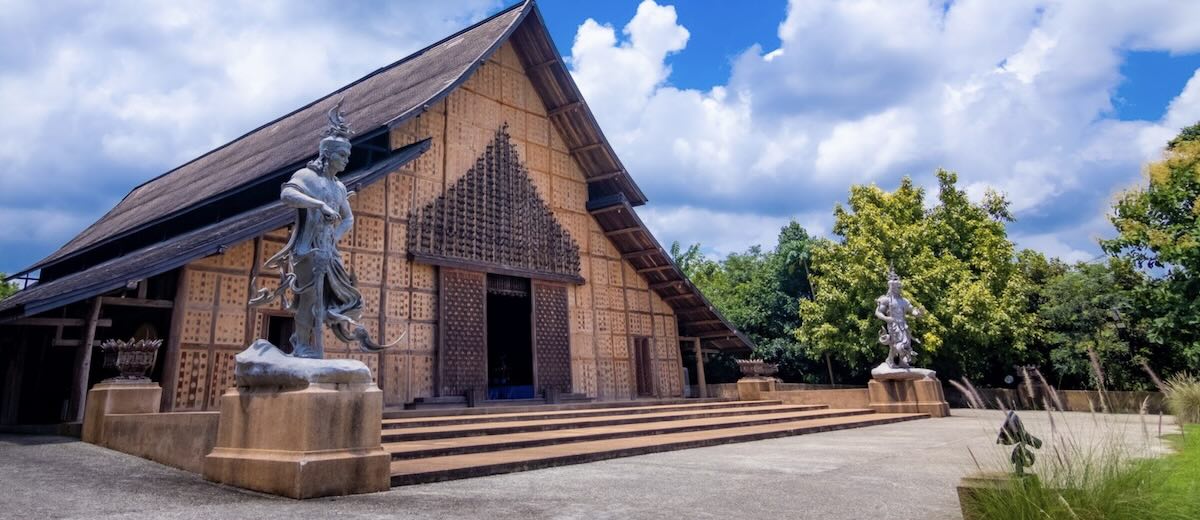
Here is a locally well-known meditation center in the far north of Thailand in a small area called Chiang Rai. The information below should be current. Please note that phone numbers will almost surely be answered in Thai language.
All Meditation Retreats in Thailand >
Cherntawan International Meditation Center in Chiang Rai, Thailand
Meaning of the Name
The name “Rai Cherntawan” translates roughly as “the farm that welcomes the sun.” The image is meant to suggest opening oneself to light, clarity, and wisdom. The full Thai name refers to it as an international Vipassana meditation center.
Address
Cherntawan International Meditation Center
217 Moo 25, Ban Mai San Pa Hiang, Huai Sak Subdistrict
Mueang District, Chiang Rai Province, Thailand 57000
Telephone numbers often listed for contact are:
+66 (0)82-804-8954, +66 (0)80-632-3226, +66 (0)94-829-2493, +66 (0)98-781-7933
Direction
The center sits about 18 kilometers from downtown Chiang Rai. It’s located in Huai Sak Subdistrict, on the road leading toward Thoeng District. From Huai Sak Market, turn right at the traffic light and follow the signs for a short distance. Travelers should know that there isn’t public transport directly to the meditation center. You’ll need to arrange your own vehicle or hire a driver.
GPS coordinates (approximate) – 19.762429, 99.876091
Setting and Atmosphere
The meditation center covers a large area of land, shaded by trees and landscaped gardens. Sculptures, water features, and a central wooden meditation hall create an inviting and peaceful environment. The grounds are arranged for walking, quiet contemplation, and group practice. Visitors will notice large statues symbolizing Buddhist values, as well as art installations that connect spiritual teachings with creative expression.
The property size is sometimes reported differently, ranging from about 140 rai up to nearly 190 rai (roughly 55 to 75 acres). Regardless of the number, it’s a spacious site with plenty of open areas, shaded paths, and tranquil corners.
Meditation Approach
This is a Vipassana-based center, but rather than focusing on one rigid technique, it offers a blend of methods introduced by the founder, Phra Maha Vudhijaya Vajiramedhi. The focus is on mindfulness, insight, and practical application of the Buddha’s teachings in modern daily life.
Courses range from short introductions for newcomers to multi-day retreats for those who want more immersion. Both group sittings and periods of private practice are available. The center also combines teachings with visual art, exhibits, and sculptures to help spark reflection and awareness.
Teaching Style
- Meditation sessions are guided by resident monks, often with introductory explanations.
- Dhamma talks and discussions form part of the program.
- Visitors are encouraged to do self-practice on the grounds between formal sessions.
- Walking meditation is a common feature, supported by shaded pathways and natural surroundings.
Participation for Visitors
The center is open daily during daylight hours. Day visitors are welcome to explore the grounds, attend meditation, or sit quietly on their own. There is no entry fee. For short or long retreats, it’s best to contact the center in advance, though casual visitors can simply arrive and ask the monks if they may join in practice.
Meditation Teachers
The center was established by Phra Maha Vudhijaya Vajiramedhi, a well-known monk and teacher in Thailand. He is supported by other resident monks who help with teaching and guiding meditation sessions. Some monks are able to communicate in English, making it easier for international visitors.
Language
Most of the teaching is conducted in Thai. However, since the center is designed with international visitors in mind, English is sometimes used in retreats, especially the longer courses aimed at foreigners.
Retreats and Daily Rhythm
Programs vary depending on the group and the retreat length. Typical options include:
- One-day introductions
- Two- to four-day retreats for students or working professionals
- Seven-day retreats for international participants
- Nine-day retreats for monastics or more serious practitioners
While the specific hour-by-hour schedule isn’t published, retreats usually include morning and evening chanting, periods of sitting and walking meditation, Dhamma talks, and time for reflection.
Food
There is a small café on the grounds for casual visitors. For retreat participants, simple meals are typically provided in the Thai Buddhist tradition, with two main meals earlier in the day. The food is vegetarian-friendly and intended to support practice rather than indulgence.
Accommodation
For those attending retreats, accommodation is available on site. Guests may stay in simple dormitory rooms or basic retreat housing. These facilities are designed for meditation practice and are not luxury oriented.
Advance Booking
If you plan only a short visit to meditate or walk the grounds, you can simply arrive during open hours. If you’d like to join a structured retreat or stay overnight, it’s recommended to make arrangements with the center beforehand.
Ordination
There is no clear public information that this center offers ordination for monks or nuns. Its primary role is to provide meditation retreats and spiritual education rather than serving as a full ordination temple.
Other Notes
- The center combines Buddhism with creative expression, hosting art exhibits and sculptures across the property.
- It continues to function as a meditation and Dhamma center that draws both Thai and international visitors.
